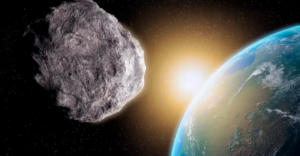Asteroid Apophis: India’s Space Agency on High Alert (2029)
Asteroid Apophis: India’s Space Agency on High Alert Asteroid Apophis is approaching Earth in 2029. India’s ISRO is closely monitoring it. International space agencies are planning missions to study and potentially alter its trajectory.
CONTENTS: Asteroid Apophis: India’s Space Agency on High Alert

Asteroid Apophis: India’s Space Agency on High Alert (2029)
2024 RN16 close pass today
Asteroid Apophis: India’s Space Agency on High Alert September 14, 2024, an asteroid named 2024 RN16 will make a close pass by Earth at 08:46 UTC (2:16 PM IST). This asteroid, measuring 110 feet across and moving at a speed of 104,761 km/h, will come within 1.6 million kilometers of our planet.
2024 RN16 is part of the Apollo asteroid group, which includes near-Earth objects with orbits that intersect Earth’s path around the Sun. These asteroids are named after the first one discovered in this group, 1862 Apollo. NASA keeps a close watch on Apollo asteroids due to their potential to cross Earth’s orbit.
2024 RN16 poses no threat
Asteroid Apophis: India’s Space Agency on High Alert: If an asteroid the size of 2024 RN16 were to collide with Earth, the consequences would be highly destructive. It is estimated that such an asteroid would explode 29 kilometers above the surface if it entered the atmosphere, releasing energy equivalent to 16 megatons of TNT.
This explosion would create a substantial shockwave but would not result in a direct impact on the ground. Events of this magnitude are projected to occur approximately once every 990 years. Fortunately, 2024 RN16 will safely pass by Earth without posing any danger.
NASA’s Center for Near-Earth Object Studies (CNEOS) monitors asteroids and comets to evaluate their potential impact risks. The tracking of these objects relies on data from global observatories and amateur astronomers. The Minor Planet Center collects this data, while observatories like Pan-STARRS and NEOWISE offer detailed observations. Additionally, planetary radar systems such as the Goldstone Solar System Radar help to refine asteroid trajectories.
“Thanks to NASA’s diligent monitoring, Earth is safeguarded from the threats posed by space rocks like 2024 RN16,” stated a NASA spokesperson.
Apophis close approach in 2029
Asteroid Apophis: India’s Space Agency on High Alert: The Indian Space Research Organisation (ISRO) is actively monitoring the asteroid Apophis, which is predicted to come very close to Earth on April 13, 2029. Named after the Egyptian God of Chaos, Apophis is larger than both India’s INS Vikramaditya aircraft carrier and the Narendra Modi Stadium in Ahmedabad.
ISRO’s newly established planetary defense division is dedicated to safeguarding Earth from potential extraterrestrial threats. In a recent NDTV interview, ISRO Chairman Dr. S. Somanath emphasized, “A significant asteroid impact represents a genuine existential threat to humanity.
ISRO is acutely aware of this risk, and our Network for Space Objects Tracking and Analysis (NETRA) is closely monitoring Apophis. We only have one Earth, and India is committed to collaborating with other nations to address this and similar future threats.”
Apophis, discovered in 2004, has been tracked for its recurring close approaches to Earth. Its 2029 flyby will bring it within 32,000 kilometers of our planet, closer than many geostationary satellites. Although some studies indicate that it may not pose a collision risk, its proximity raises significant concern.
Apophis study missions planned
Asteroid Apophis: India’s Space Agency on High Alert: Historical asteroid impacts, such as the meteor strike at Lonar in Maharashtra about 500,000 years ago, underscore the potential hazards of space rocks. The Lonar impact site is now marked by a crater lake. Dr. Somanath commented, “ISRO will certainly examine the Apophis asteroid closely during its nearest approach in 2029.”
To address this threat, international space agencies are planning missions to study and possibly alter Apophis’s trajectory. NASA’s OSIRIS-REx, which recently returned samples from another asteroid, is being redirected to Apophis.
Additionally, the European Space Agency is contemplating the launch of the Rapid Apophis Mission for Security and Safety (RAMSES) in 2028, potentially in collaboration with India.
Check out TimesWordle.com for all the latest news
You must be logged in to post a comment.